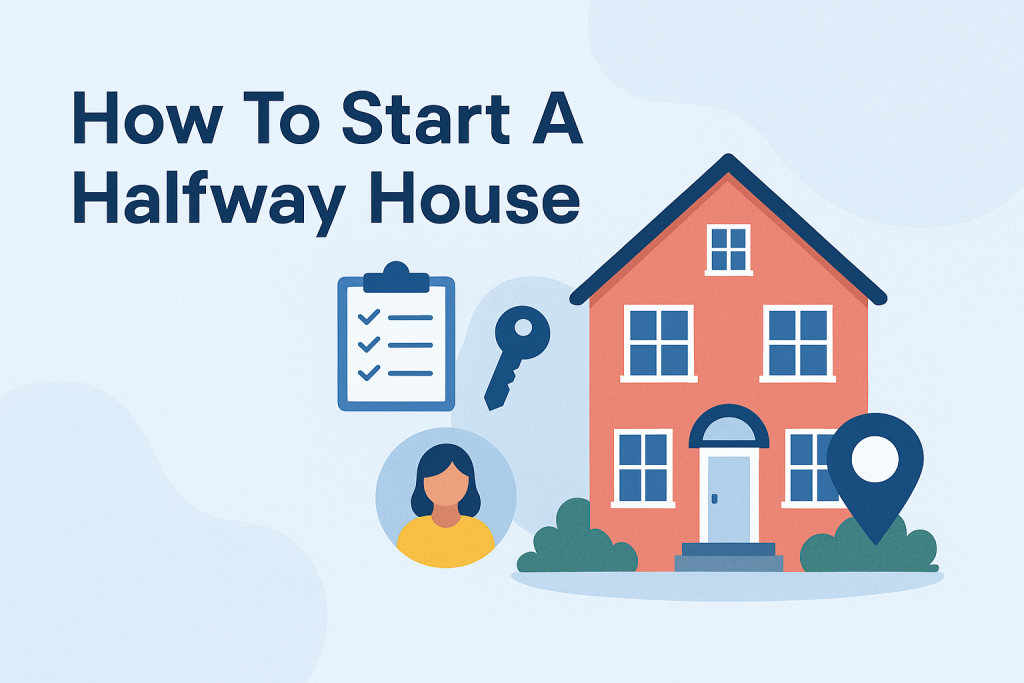Creating supportive environments for people rebuilding their lives offers both social value and financial potential. Recent data shows over 20 million Americans faced substance challenges in 2018, with many needing structured support after treatment programs. This demand makes transitional housing services more vital than ever.
Transitional residences bridge the gap between intensive care and independent living. Unlike temporary government-funded options, modern sober living homes allow flexible stays while maintaining accountability through community guidelines. Each occupied bed can generate $500 monthly, creating sustainable revenue while serving a critical community need.
Successful operations balance compassionate care with smart business practices. Nearly 67% of individuals with less than twelve months’ sobriety benefit from structured environments, according to recovery studies. This reality underscores the importance of well-designed facilities that promote lasting recovery.
New operators must navigate zoning laws, licensing protocols, and resident safety standards. Effective marketing strategies also help connect services with those needing support. This guide explores practical steps for launching facilities that transform lives while building stable revenue streams.
Key Takeaways
- Transitional housing addresses growing demand from individuals rebuilding after addiction or incarceration
- Sober living environments differ from traditional halfway houses in duration and funding models
- Each residential bed generates substantial monthly income potential
- Proper licensing ensures compliance with state and local regulations
- Effective operations combine compassionate care with business sustainability
Understanding the Concept and Benefits of Halfway Houses
Recovery-focused housing bridges the gap between clinical treatment and independent living. These environments provide stability when individuals need it most – after completing rehabilitation programs but before fully rejoining society. Let’s explore why these spaces matter and how they create lasting change.
Structured Support for Sustainable Recovery
Sober living homes operate on accountability and community. Residents follow house rules like curfews and mandatory meetings while rebuilding life skills. “Peer relationships formed here often become lifelong support systems,” notes a 2024 recovery study. Regular drug tests and employment coaching further strengthen residents’ progress.
These facilities differ from temporary shelters by offering extended stays. Most residents stay 6-18 months, allowing time to secure jobs and save money. Shared responsibilities like meal preparation foster teamwork – crucial for rebuilding trust and self-esteem.
Community Transformation Through Individual Growth
Every successful reintegration story strengthens neighborhoods. Data shows people in transitional housing programs are 40% less likely to reoffend compared to those without support. This ripple effect reduces strain on public resources while adding productive community members.
“Residents enrolled in outpatient programs while in sober living homes have 58% higher employment rates after six months.”
Operators find purpose and profit in this model. A 12-bed facility can generate over $70,000 annually while changing lives. Demand grows as courts and hospitals increasingly recommend these homes for sustained recovery success.
How to Start a Halfway House: Essential Steps and Requirements
Launching a sober living facility requires balancing legal compliance with operational strategy. Regulatory approvals and financial planning form the foundation for sustainable services that meet community needs. To explore a step-by-step guide on organizing a supportive homeschool community with shared responsibilities, take a look at how to start a homeschool co‑op.
Navigating Legal Requirements
Every state sets unique rules for recovery residences. California’s Department of Health Care Services mandates licenses for facilities offering clinical support, while Texas exempts homes without medical services. Zoning laws often require residential property near transit and job centers.
How to open a sober living home and what are the basic requirements?
Learning how to open a sober living facility requires understanding local zoning laws, obtaining proper licensing, and creating a structured recovery environment. The process for how to start a halfway house in texas involves registering with the state, meeting fire safety codes, and potentially obtaining NARR (National Alliance for Recovery Residences) certification. Effective halfway house marketing strategies include partnering with treatment centers, building relationships with therapists and counselors, and maintaining a strong online presence. Understanding how to open a halfway house or how to open halfway house begins with researching your state’s specific regulations and insurance requirements. For how to start a halfway house in california, you’ll need to comply with stricter regulations including the Alcoholism and Drug Abuse Counselor Certification. When learning how to start a sober living home, focus on creating clear house rules, hiring qualified staff, and establishing admission criteria. The process for how to start a sober living home in california includes registering as a business entity and potentially joining sober living coalitions for credibility and support.
Learning how to open a sober house starts with creating a comprehensive sober living home business plan for your halfway house business, understanding specific state requirements like how to open a sober living house in california or how to start a sober living home in ohio, knowing how to open a sober living home in california with proper permits, discovering how to set up a sober living house infrastructure, determining do you need a license to open a halfway house in your area, researching how to open a halfway house in texas regulations, understanding how to open up a sober living home successfully, learning how to start a recovery home that serves your community, and properly opening a recovery house that provides safe, supportive housing for individuals in recovery.
What are the requirements to open a sober living house and how do you start?
The specific requirements to open a sober living house vary by state but typically include proper zoning permits, business licenses, insurance coverage, and adherence to fair housing laws. To successfully start a sober living home, you’ll need adequate funding (typically $10,000-50,000), a suitable property that meets occupancy standards, and clear operational policies. Most states require background checks for operators, written house rules, and emergency procedures. Some jurisdictions mandate staff training in addiction recovery, while others require partnerships with licensed treatment providers. Creating a sustainable business model involves understanding reimbursement options, whether through private pay, insurance contracts, or government funding. Success depends on balancing compassionate care with sound business practices while maintaining a safe, supportive environment for residents in recovery.
Voluntary certification through groups like the National Alliance for Recovery Residences boosts credibility. “Accredited facilities see 30% faster occupancy rates,” reports a 2024 industry analysis. Always consult local ordinances before finalizing locations.
Building Operational Foundations
A detailed business plan outlines staffing needs, resident programs, and revenue streams. Financial projections should account for $3,000-$8,000 in monthly expenses per bed. Include marketing tactics to connect with referral networks like courts and rehab centers.
Experienced consultants help avoid common pitfalls. Their guidance ensures facilities meet safety standards while maintaining budget flexibility. This preparation creates environments where residents thrive and operations remain sustainable.
Learning how to start a transitional housing business requires understanding local regulations and community needs, implementing proper halfway house coordination systems for resident management and support services, and discovering how do i open a halfway house involves securing appropriate licensing, funding, property, and developing comprehensive programs to help residents successfully transition back into independent living.
Navigating State Regulations and Industry Best Practices
State regulations shape the foundation of every successful recovery residence. Understanding regional differences proves vital for maintaining compliance while accessing funding opportunities. Let’s examine contrasting approaches in two key states.
California Licensing and Zoning Considerations
California enforces strict state oversight through its Department of Health Care Services. Facilities offering drug treatment services must obtain licenses demonstrating staff qualifications and program efficacy. Zoning laws often require sober living homes near public transit and employment centers.
The Golden State provides multiple funding resources for operators. SAMHSA grants and USDA loans help cover startup costs for qualified facilities. “Proper certification opens doors to sustainable funding streams,” notes a California housing coordinator.
Understanding how to start a sober living house requires careful planning, similar to learning how to open up a halfway house, as opening a halfway house involves meeting specific halfway house requirements and determining how much does it cost to start a halfway house in your area, whether you’re discovering how to open a halfway house in california or elsewhere, the process parallels how to open a recovery house and how to start a recovery house, with how to start a sober house following similar guidelines to how to start halfway house operations, and as you explore how to start sober living house options, starting a halfway house becomes achievable with proper licensing, funding, and commitment to helping individuals in recovery.
-
For those looking to enter a niche yet growing industry, this article on building a mobile DNA testing enterprise outlines key steps and legal considerations.
-
Ohio’s Regulatory Landscape and Resource Guides
Ohio takes a decentralized approach, exempting private sober living homes from mandatory licensure. Their tiered classification system clarifies operational expectations:
- Level 1: Peer-supported Oxford Model homes
- Level 2: Staff-supervised residences
- Level 3: Clinically integrated programs
The Ohio Department of Mental Health provides detailed development toolkits. These resources help operators navigate housing regulations while creating effective recovery environments. This practical support makes Ohio attractive for new facility development.
Key Elements for Facility Management and Resident Support
Effective sober living home operations require strategic planning and compassionate execution. Balancing daily responsibilities with long-term recovery goals creates environments where growth becomes inevitable for both residents and organizations.
Staffing Foundations That Foster Trust
House managers form the backbone of successful operations. These leaders typically maintain 6-12 months of continuous sobriety, offering lived experience that builds trust. Many receive housing benefits as part of their compensation package, creating mutual investment in the home’s success.
Clear policies establish essential boundaries while encouraging personal responsibility. Mandatory drug screenings, chore rotations, and guest protocols protect all residents. “Our handbook becomes their roadmap,” shares a Texas manager with three years’ experience. Regular staff training ensures consistent enforcement while adapting to individual needs.
Digital Tools for Modern Operations
Specialized apps revolutionize management tasks. The Sober Living Manager platform handles:
- Automatic rent payments and financial tracking
- Digital logs for medication and counseling attendance
- Real-time communication between staff and support networks
“Mobile tools cut administrative hours by 40% while improving care coordination.”
Structured daily programs reinforce healthy routines. Morning check-ins and evening reflection circles create predictable rhythms that reduce anxiety during recovery transitions. These elements combine to build communities where lasting change thrives.
Marketing Strategies and Community Integration
Connecting those in recovery with essential services requires strategic outreach and neighborhood collaboration. Effective communication builds trust with potential residents while demonstrating value to local stakeholders.
Leveraging Online and Offline Marketing Channels
Modern sober living homes thrive through blended marketing approaches. Search-optimized websites rank for terms like “recovery support near me,” while social platforms showcase success stories. Print materials distributed to clinics and courts complement digital efforts.
| Channel | Best Uses | Engagement Tips |
|---|---|---|
| Social Media | Building community trust | Share resident milestones (with consent) |
| Local Directories | Targeting regional searches | Include transportation details |
| Professional Networking | Securing referrals | Host facility tours for providers |
“Facilities with active Instagram accounts fill beds 22% faster than those relying solely on word-of-mouth.”
Building a Supportive Community Network
Location advantages like nearby bus routes and grocery stores become key selling points. Partnering with employers creates job opportunities for residents, while volunteer programs foster neighborhood connections.
Monthly open houses address community questions transparently. These events often convert skeptics into allies by showcasing structured programs and success metrics. Strong local ties lead to lasting support networks for everyone involved.
Conclusion
Establishing a sober living home combines compassionate service with practical business strategy. With 926,000 Ohio residents needing substance support and similar patterns nationwide, well-designed recovery housing fills critical gaps in community health systems.
Successful operations balance location advantages with staff expertise. Properties near public transit and healthcare providers see higher resident retention. Trained managers who understand recovery processes create environments where lasting change flourishes.
Modern tools simplify daily operations while maintaining accountability. Digital platforms handle rent payments and program tracking, freeing staff to focus on resident support. These innovations make sober living homes accessible for new operators committed to social impact.
Building neighborhood partnerships strengthens both operations and outcomes. Local employers and healthcare networks become vital allies, providing resources while demonstrating community value. This collaborative approach ensures facilities thrive as essential recovery resources.
The path forward requires dedication to standards and relationships. Through thoughtful planning and genuine care, these homes transform lives while building sustainable models for long-term success.







